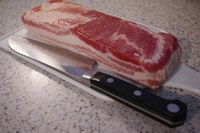Prairie Fare: Savor the Flavor of Bacon but in Moderation
(Click the image below to view a high-resolution image that can be downloaded)
By Julie Garden-Robinson, Food and Nutrition Specialist
NDSU Extension Service
“Mom, I just had the best cookies ever! I ate a bunch at the dining center. You need to make them at home,” my 18-year-old son exclaimed. He was practically salivating.
“What kind of cookies were they, anyway?” I inquired.
“They were bacon chocolate-chocolate chip cookies. They were featuring bacon on the menu,” he replied with a grin.
I did a quick online search and found several cookie recipes with crumbled bacon bits.
As he continued his glowing culinary review, I had a flashback from 18 years ago. I experienced a craving for bacon while expecting him. Was this a delayed effect?
At the time I was pregnant with my now 6-foot-3-inch son, I was teaching a food service management class twice a week in the campus dining service kitchen. It was near the same time of year as my son’s present-day “bacon encounter.”
My buddy, who was the head cook, would greet me with, “Julie, your bowl of bacon is on the counter.”
I looked forward to my flavorful treat and waddled over to retrieve it. As the months progressed, I needed to temper my intake of higher-sodium foods, including bacon, when my feet began to swell and I grew out of my shoes.
I savored the flavor of one piece of bacon instead of three. Obviously, my craving didn’t stunt my son’s growth.
The 2012 Bacon Report referred to its namesake as “meat candy.” More than 627 million pounds of bacon was sold in retail outlets in 2012.
A slice of bacon isn’t as high in calories or fat as you might expect. According to the U.S. Department of Agriculture Nutrient Database, one slice of pan-fried bacon has 54 calories and 4 grams (g) of fat.
One slice of cooked bacon has 194 milligrams of sodium. That’s about 13 percent of the daily sodium recommendation for people 51 and older and 8.4 percent of the recommendation for people younger than 51.
When cooking bacon, start the process in a cold pan and cook to desired doneness over medium heat. You also can cook bacon in an oven or microwave oven. Drain the bacon on a double layer of paper toweling to reduce the fat content. You can cut back on added salt or added fat if you are adding bacon to a dish, such as a soup or casserole recipe. Top off your menu with a side salad, fruit, veggies and other food naturally low in sodium and high in nutrients.
Bacon appears in many ways on restaurant menus besides being a popular side dish for eggs at breakfast. Bacon often inspires sales by appearing on sandwiches, salads and pizzas. It serves as wrap around shrimp, scallops and pork loins. Bacon also has been used in cocktails and desserts, including sundaes, cookies and brownies.
Typically, “standard” cut bacon is sold in 1/16-inch slices, but some people prefer thick-cut bacon, which is about 1/8-inch thick. If you visit most butcher counters, you can buy bacon in slabs, which you cut at home. You also might find “center-cut” bacon, which is lower in fat because the bacon is cut close to the bone.
Bacon is a pork product, so religious restrictions prevent some groups from using it on their menus. “Turkey bacon” is available and others have made baconlike products from lamb, beef, soy and other proteins.
If you want to profess your love of bacon visually, you can decorate yourself or your office with numerous bacon-inspired items. I could wear plastic bacon strip earrings and a bacon apron. I could use a mouse pad imprinted as a slab of bacon. If I cut myself while cutting bacon “lardons” (small pieces of bacon), I could use a bacon-colored bandage to cover my wound.
Before we go “hog wild” about bacon, we need to keep moderation in mind. Bacon is highly flavorful, so a sprinkle of bacon crumbles adds a lot of flavor to a baked potato or a spinach salad. To moderate your intake of sodium, try the reduced-sodium versions of bacon that are available.
Here is a recipe adapted from the Spend Smart Eat Smart program at Iowa State University Extension and Outreach.
Loaded Potato Soup With Bacon Crumbles
3 c. red potatoes, peeled, cooked and mashed
1 Tbsp. margarine (soft, tub-style)
1 c. onion, chopped
1/2 c. green or red pepper, chopped
1 (14.5-ounce) can chicken broth, reduced-sodium
1 c. fat-free milk
1 c. frozen peas (or mixed vegetables), thawed
1/2 tsp. pepper
4 slices (3 ounces) American cheese
4 strips reduced-sodium bacon, fried and crumbled
1/2 c. green onion, diced
Fat-free sour cream (optional)
Peel, cook and mash potatoes. Fry bacon until crumbly, drain well and set aside. Melt margarine in a sauce pan over medium heat. Stir in green or red pepper and cook for about five minutes, until the pepper is softened. Stir in broth and heat to a boil. Add milk and vegetables. Heat through, stirring occasionally. Add the cheese slices, cooking and stirring for about two minutes. If desired, add additional milk to reach the desired consistency. Serve immediately. Top with crumbled bacon, green onion and, if desired, fat-free sour cream.
Makes six servings. With reduced-sodium bacon, each serving has 200 calories, 7 g of fat, 9 g of protein, 24 g of carbohydrate, 3 g of fiber and 450 milligrams of sodium.
(Julie Garden-Robinson, Ph.D., R.D., L.R.D., is a North Dakota State University Extension Service food and nutrition specialist and professor in the Department of Health, Nutrition and Exercise Sciences.)
NDSU Agriculture Communication – Feb. 20, 2014
| Source: | Julie Garden-Robinson, (701) 231-7187, julie.garden-robinson@ndsu.edu |
|---|---|
| Editor: | Rich Mattern, (701) 231-6136, richard.mattern@ndsu.edu |


